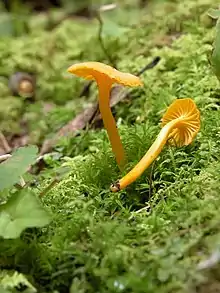| Cantharellus minor | |
|---|---|
 | |
| Scientific classification | |
| Domain: | Eukaryota |
| Kingdom: | Fungi |
| Division: | Basidiomycota |
| Class: | Agaricomycetes |
| Order: | Cantharellales |
| Family: | Cantharellaceae |
| Genus: | Cantharellus |
| Species: | C. minor |
| Binomial name | |
| Cantharellus minor Peck (1872) | |
| Synonyms | |
| Cantharellus minor | |
|---|---|
| Ridges on hymenium | |
| Cap is convex | |
| Hymenium is decurrent | |
| Stipe is bare | |
| Spore print is yellow | |
| Ecology is mycorrhizal | |
| Edibility is edible | |
Cantharellus minor is a fungus native to eastern North America.[1] It is one of the smallest of the genus Cantharellus, which includes other edible chanterelles. It is suspected of being mycorrhizal, found in association with oaks and moss.[1] Recently, C. minor has been reported from semi-evergreen to evergreen forests in the Western Ghats, Kerala, India forming ectomycorrhizal associations with tree species like Vateria indica, Diospyros malabarica, Hopea parviflora, and Myristica species.[2] The cap of C. minor ranges from 0.5 to 3.0 cm (0.2 to 1.2 in) wide and is convex and umbonate, often shallowly depressed, becoming funnel-shaped in some. The yellowish gills are decurrent, and fade to yellowish white in maturity.[2] The stipe is less than 4 cm (1.6 in) tall. They fruit in the summer and fall.[3] Although insubstantial, they are edible.[4]
References
- 1 2 Kuo, M. (February 2006). "Cantharellus minor". MushroomExpert.Com. Retrieved 2011-03-24.
- 1 2 Mohanan C. (2011). Macrofungi of Kerala. Kerala, India: Kerala Forest Research Institute. ISBN 978-81-85041-73-5.
- ↑ Miller Jr OK.; Miller HH. (2006). North American Mushrooms: A Field Guide to Edible and Inedible Fungi. FalconGuides. Guilford, CN: Globe Pequot Press. p. 334. ISBN 978-0-7627-3109-1.
- ↑ "Cantharellus minor". Rogers Plants. Archived from the original on 2011-11-07. Retrieved 2011-05-08.
External links